- Set Up Project Folder and Open Data;
- SPSS Data File Inspection;
- SPSS Categorical Variable Inspection;
- SPSS Metric Variable Inspection;
- Optionally: Edit Data;
- Choose and Run Tables/Charts/Tests.
1. Set Up Project Folder and Open Data
The biggest waste of time and effort in SPSS is probably not keeping projects organized. A related pitfall is not regularly making backup copies of the entire project. Avoiding this starts with setting up a project folder that'll contain all of your data -original and edited-, syntax and output files.
We recommend you never edit your original data and keep it in a safe place. For me, that's usually a subfolder called “ori”, short for “original data”. Make sure that the project contains all files you'd like to backup -and nothing else.
Done setting up a decent project folder? Then let's go and open the data.
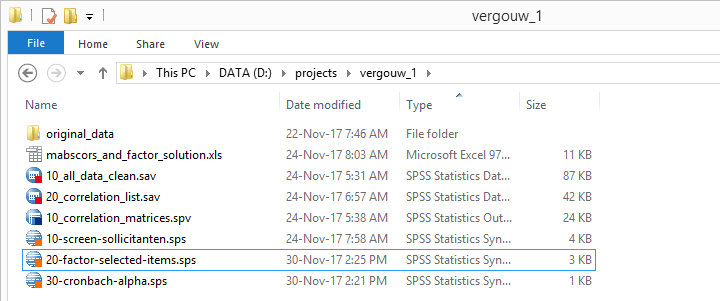 Keeping this project nicely organized saved me way more time than it cost me.
Keeping this project nicely organized saved me way more time than it cost me.
2. SPSS Data File Inspection
At this point we know which variables in our data -possibly all- we're actually going to use. A sound way to proceed from here is inspecting our data visually. Some things we need to know are
- is there a unique case identifier?
- are there excessively long variable names?
- are there any undesired string variables?
- are all variables and values clearly labeled? Is it absolutely clear what everything really means? If not, don't guess. Instead, obtain this information -preferably via email- from whomever is responsible for delivering accurate and complete data to you.
If you encounter any such issues, fix them right away. The sooner you troubleshoot such issues, the less time and effort they'll cost you.
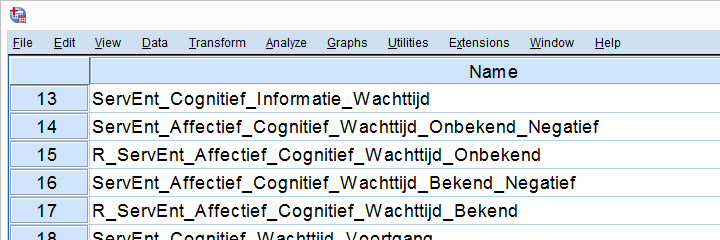 Shortening these variable names and applying variable labels saves more effort than it costs
Shortening these variable names and applying variable labels saves more effort than it costs
At this point our data should be technically in order. So what about the contents of our variables? I suggest you carefully check these for categorical variables and metric variables separately.
3. SPSS Categorical Variable Inspection
We inspect categorical variables by
- running frequency tables showing both values and value labels and
- inspecting the corresponding bar charts.
A single line FREQUENCIES command suffices for many variables in one go. Issues we typically look for are:
- are any ordinal variables reversely coded (lower values indicating higher ratings)? If so, see SPSS - What’s the Best Way to Reverse Code Variables?
- should any user missing values be specified?
- are all frequency distributions plausible? That is, do all variables make sense?
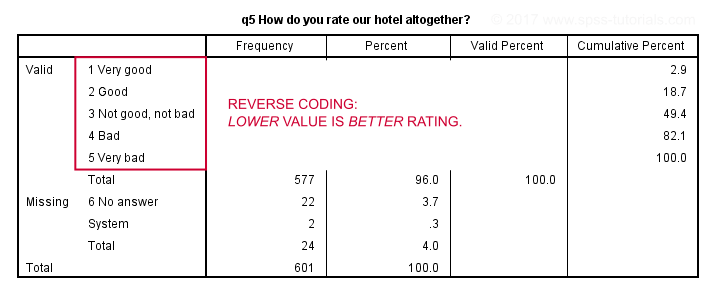 Reverse coded variable - not really wrong but inconvenient nevertheless.
Reverse coded variable - not really wrong but inconvenient nevertheless.
If any such issues are present, try and fix them. If they can't be fixed, perhaps take some notes so you won't have any nasty surprises later on.
4. SPSS Metric Variable Inspection
We inspect metric variables by
- running basic histograms over them and
- inspecting simple DESCRIPTIVES tables.
Note that you can run many histograms with a single line FREQUENCIES command as shown in Creating Histograms in SPSS. Histograms basically tell you all you need to know. Issues to look out for are
- are all distributions plausible? What about the means and standard deviations?
- are there any extreme values -either very large or very small- that must be specified as user missing?
- do any variables have many system missing values?
Next, a basic DESCRIPTIVES table comes in handy for checking the completeness of a set of variables. It'll also allow for a quick comparison of means and standard deviations.
After completing these steps, we can be confident that our data are sound. Nothing incorrect or unusual can mess up any newly created variables or test results anymore. Now -and only now- should we proceed with editing or analyzing our data. As a bonus, we also know what our data basically look like.
5. Optionally: Edit Data
Perhaps your research questions relate to variables that still need to be created or adjusted. Well, this is the moment to do so. Our most read tutorials on common data adjustments are
- SPSS Date Variables Tutorial
- How to Compute Age in SPSS?
- SPSS IF Command
- SPSS RECODE Command
- How to Compute Means in SPSS?
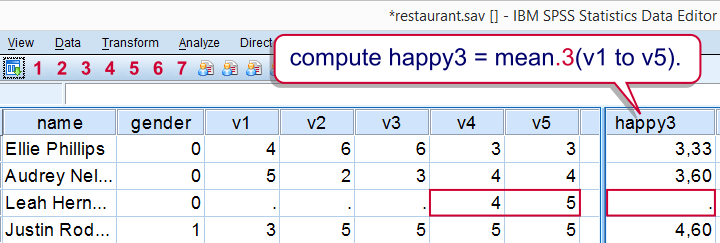 A nice -syntax only- trick for excluding cases with many missings when computing means
A nice -syntax only- trick for excluding cases with many missings when computing means
Hope those will get you started. Really, do adjust your data if needed. This often results in much nicer output with much less effort.
6. Choose and Run Tables, Charts & Tests
First off, which tables, charts and tests are appropriate is a complicated question that doesn't have a simple answer. Oftentimes, different approaches are equally defensible.
In any case,
the simplest analysis techniques examine each variable separately.
These are called univariate analyses (“univariate” means “for one variable”). As shown below, we should at least distinguish categorical from metric variables.
Minimal Overview Univariate Analyses
| Level | Table | Chart | Test |
|---|---|---|---|
| Categorical | FREQUENCIES | Bar chart frequencies | Binomial test (2 categories) Chi-square goodness-of-fit test (3+ categories) |
| Metric | DESCRIPTIVES | Histogram | One-sample t-test (mean) Kolmogorov-Smirnov test (distribution) |
A next step could be to examine if 2 variables are associated in any way. This involves bivariate analyses (“bivariate” means “for 2 variables”). Distinguishing categorical from metric variables once again, we arrive at the simple overview below.
Minimal Overview Bivariate Association Analyses
| Variable A | Variable B | Table | Chart | Test |
|---|---|---|---|---|
| Categorical | Categorical | CROSSTABS | Stacked bar chart percentages | Chi-square independence test |
| Metric | Categorical | MEANS | Bar chart means by category | Independent samples t-test (2 categories) One-way ANOVA (3+ categories) |
| Metric | Metric | CORRELATIONS | Scatterplot | Correlation test (non directional) Simple linear regression (directional) |
If you properly understand these tests, you'll start to see that most statistical tests are variations on these big 5 tests. For example,
- multiple regression is simple regression with more than 1 predictor;
- logistic regression is just regression with a dichotomous outcome variable;
- the Kruskal-Wallis test is basically a one-way ANOVA on ranked scores. And so on...
Is that all? No, not quite. First off, we only mentioned categorical and metric variables. Ideally, we'd distinguish
- dichotomous variables;
- nominal variables;
- ordinal variables and;
- metric variables.
We don't always need to treat these all separately but doing so results in a much more complete overview. We're working on it but it'll take another while.
For now, perhaps consult Which Statistical Test Should I Use?, part of which is shown below. Unfortunately, this overview is limited to statistical significance tests and does not suggest which tables and charts to use.
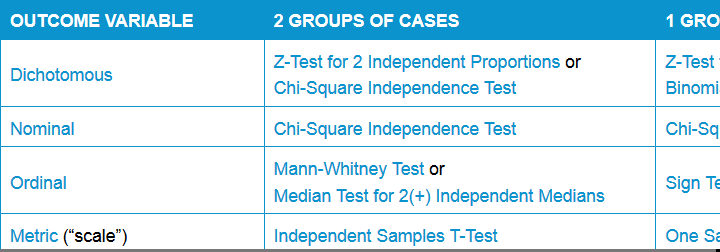 Simple overview statistical comparison tests
Simple overview statistical comparison tests
Thanks for reading!
 SPSS TUTORIALS
SPSS TUTORIALS
THIS TUTORIAL HAS 11 COMMENTS:
By SOPHE MAKOLOMA on August 2nd, 2015
The explainations are clear, i just have to find my fit..how i can make use of these
By James McMahon on December 11th, 2017
This might save a bit of time when writing syntax and I would definitely agree with most points.
However some of these can make your code harder to read, by the author or importantly by someone else. This is particularly the case with leaving out indentation and line breaks and abbreviating commands. Not least because doing these things cause the syntax highlighting to stop working.
By Ruben Geert van den Berg on December 11th, 2017
Hi James, thanks for your comment!
I agree on abbreviating commands and keywords and I stopped doing so a long time ago (note that this post is from April 2013). Also, I tend to throw in more line breaks nowadays except for some commands like GRAPH if I want to copy/paste/edit them a couple of times.
However, I still think the indentation is useless -except for the long deprecated batch syntax rules required by INCLUDE -which was replaced by INSERT ages ago.
Also, I still think most syntax pasted by SPSS is way longer and more complicated than needed.
I never saw syntax highlighting break down due to removing line breaks or indentation. If you've an example of that, please share it with me.
But anyway, I may rewrite this post from scratch some day as my syntax habits have changed a lot since I wrote it -hopefully for the better.
Another example is adding parentheses to IF statements that are still absent in the original post. I think
if(gender = 1) var1 = 1.is the way to go instead of
if gender = 1 var1 = 1.and similarly
compute var1 = (gender = 1).By James McMahon on December 11th, 2017
Hi Ruben,
Totally agree with re parenthesis in IF statements! That was one of the most confusing things for me when learning. On the syntax highlighting you are correct, the examples I was thinking of either don't break the highlighting, or completely break the syntax.
I would stand by indentation being useful for readability, especially in loops or commands with many subcommands. This is particularly so within Macros where annoying syntax highlighting doesn't function.
By Ruben Geert van den Berg on December 11th, 2017
Hi James,
I always have a blank line between commands. For me, that suffices for indicating where one command ends and the next one commences.
Are you still using macros? Perhaps try and learn a bit of Python. It's super powerful, intuitive and readable. There's a ton of examples on this website.